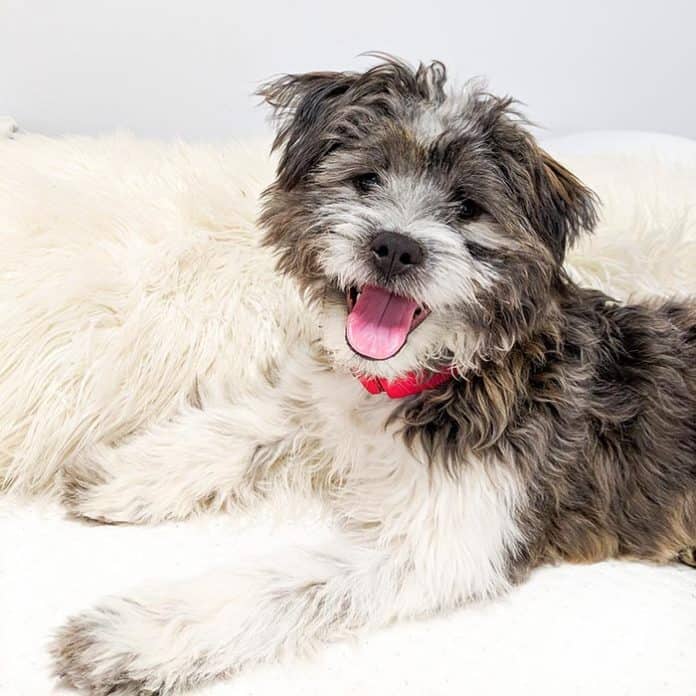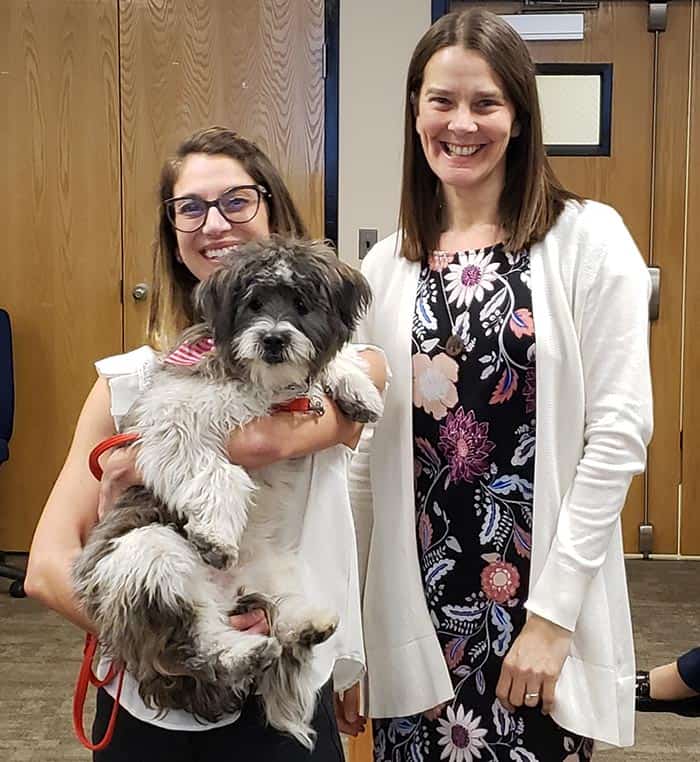
JACKSON – Sometimes when a student needs a hand out for help, the best response is the paw of a very mighty dog.
The Jackson School District recently hired a four legged employee named Mighty. He visited the Board of Education at a recent School Board meeting where he met his new employers. His job performance has already received high praise.
Mighty currently reports once a week to the Howard C. Johnson Elementary School. The school’s music teacher Melissa O’Keeffe and library teacher Carrie Hogan introduced Mighty the district’s first therapy dog, to the board at a March 19 meeting.
O’Keeffe said “Mighty is a rescue dog specifically chosen for us by the North Shore Animal League of America. Humane education is an important element in our social and emotional instruction. We were able to travel to New York City to meet Dr. Angela Hughes, the Veterinary Geneticist for Wisdom Panel, a DNA test kit for dogs.”
“After getting the results, we found Mighty was a Shih Tzu, Lhasa Apso, Maltese mix. It was very important to us that Mighty be considered a hypo-allergenic breed to avoid allergies and allow him to interact with as many students as possible,” O’Keeffe said.
Mighty is seven months old and he was adopted as a 10-week old puppy. He’s been training for this position every day since. The North Shore Animal League identified him as an excellent contender for therapy work.
“We brought him to our trainer, Shelly Liebowicz of Shelly’s School for Dogs at Green Leaf Pet Resort. Mighty attended training sessions eight hours per day, four days per week, for about two months. After that, Ms. Hogan and I attended training two days per week with specialist Katey O’Connell to learn how to be handlers. We’ve logged over 20 hours of formal training. Informally, we spent a great deal of time socializing him at public events and stores,” O’Keeffe said.
Principal Dr. Michael Raymond was a bit skeptical at first about having a canine as part of his staff. “Personally, I’m a little afraid of dogs,” Raymond said in a special video produced by students of the district’s media arts program. “I’m very proud of the work that Mrs. O’Keeffe and Mrs. Hogan did to put my mind at ease before the program could go forward. I presented it to the superintendent and he presented it to the board.”
This led to the writing of a grant application to the OceanFirst Foundation who presented a $10,000 grant to the district for costs associated with securing the therapy dog.
The idea of having a therapy dog first came about after a school community assessment. O’Keeffe said that this “was our first priority when considering the direction and design of our model classroom. We began by soliciting input from all stakeholders; students, parents, teachers, community members, and district administration. Over and over again, our stakeholders noted the lack of opportunity for students to sharpen their social-emotional skills during traditional classroom instruction.”

O’Keeffe added that “our students face increased societal, academic, and social pressures and are often not given the tools necessary to deal with them in a healthy way. Additionally, Johnson School takes a leadership role to include students with multiple disabilities into daily fine arts (art, music, library, computers, physical education) classes, not for content, but for socialization specifically.
“As our vision started to take shape, we began researching successful social-emotional programs in earnest and chose Yale University’s Mutt-i-grees program. This animal-assisted intervention program is forged by research and practice in Yale University’s lab schools. The program boasts 10 years of documented success and has been implemented by over one thousand schools in thirty states.”
Hogan told board members that “unlike the other 3,000 other schools implementing Mutti-i-grees program, we are in direct contact with the creator of the program at Yale University. She was so impressed with what we were doing that they are sending doctorial students to the Johnson School to assist us with program implementation data collection and analysis which is important to us as it will provide us markers for measuring program success.”
The Mutt-i-grees curriculum is organized around five themes which sharpen pro-social behaviors. These units include: Achieving Awareness, Finding Feelings, Encouraging Empathy, Cultivating Cooperation, and Dealing with Decisions.
Yale’s program overview states that “Mutt-i-grees builds upon children’s natural affinity for pets and provides a real-life context within which to teach social and emotional skills. Children who are socially and emotionally competent are more happy, confident, and capable across the contexts and relationships – as students, friends, family members and employees.”
O’Keeffe said adding a therapy dog to the curriculum “is seen as a great equalizer, especially when students are of varying needs and abilities.”
Student Ariana N. said therapy dogs like Mighty “are very calming. I think everyone will react in a positive way. He is a great addition to our school.”






